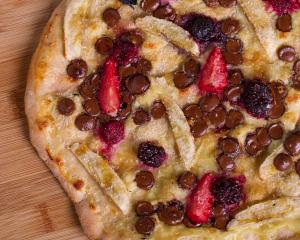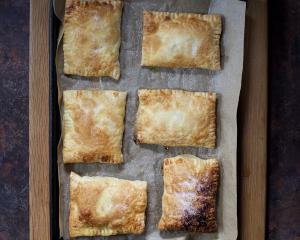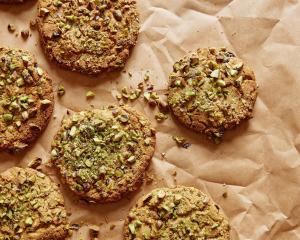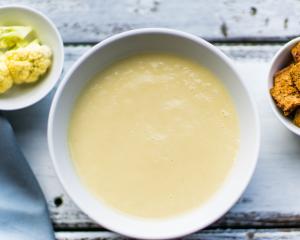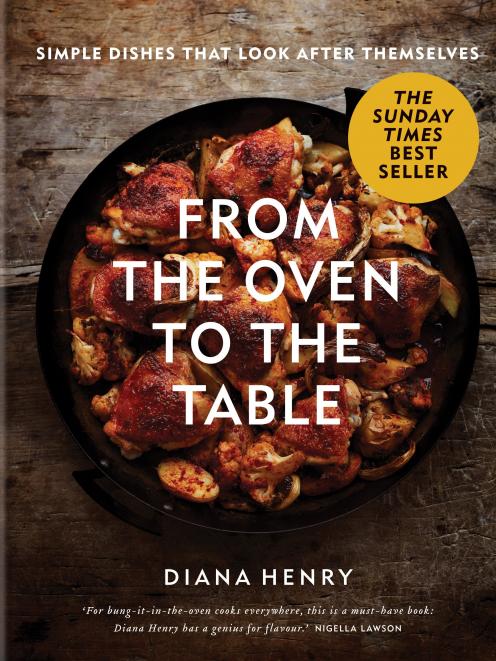
British food writer Diana Henry has filled a book with, as the sub-title of the book says, ‘‘simple dishes that look after themselves’’.
‘‘If you are a bung-it-in-the-oven kind of cook, whether by necessity or by desire, this book is for you,’’ she says.
She discovered this type of cooking — called sheet-pan cooking in America or tray bakes — when she tried an Italian recipe for chicken thighs cooked with little potatoes, red onion wedges, garlic, rosemary and olive oil which is all put in a roasting tin, seasoned and cooked in the oven for 45 minutes.
‘‘When I discovered it I silently mouthed the word ‘genius’ and knew that I had stumbled across something life-changing.’’
In the 20 years since she has built up a repertoire of dishes on this theme, some with a layer of stock poured under the meat. As the dish cooks the meat becomes golden and a sauce develops below.
‘‘I roast foods that are more usually done in a pan on the hob — sausages, broccoli and salmon fillets — because I think it’s easier. It is literally ‘‘hands off’’ cooking.’’
These recipes have helped her feed her children well and entertain no matter what day of the week.
She includes a section in the book on ‘‘kit’’ but says not a lot of fancy equipment is needed other than a good roasting tin or tray.
Many of the recipes are one-pot meals, but as she feels some could be served with a grain, bread or salad she has included a section on how to cook various grains and potatoes.
‘‘I hate being didactic — many recipes are just blueprints on which you can put your own stamp — but the food won’t turn out well if you don’t pay attention to the size of the dish, if one is specified.’’
She has dedicated one chapter to her favourite ingredient — chicken thighs.
‘‘I unashamedly love them. They’re succulent — so much better than breasts, which can dry out. In fact, it’s hard to overcook chicken thighs — they all cook at the same time (and quickly) and there’s no carving.’’
Other chapters are dedicated to summer and winter vegetables, to simple suppers, grains and pulses, to dishes for weekends and holidays and finishes with puddings and cake.
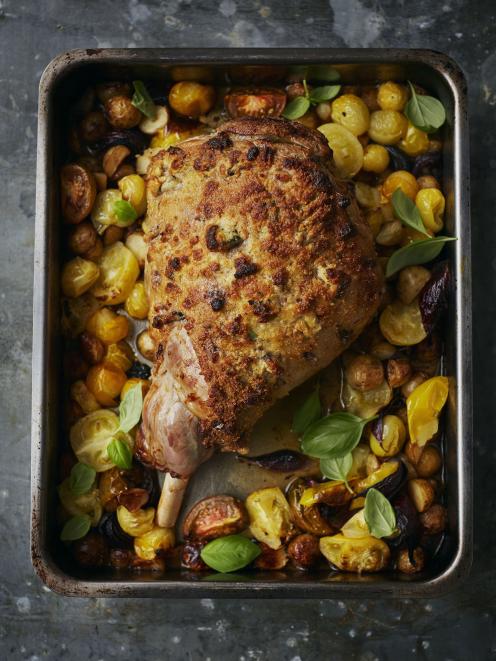 Photos: Supplied
Roast leg of lamb with basil, pecorino, garlic and wine
Photos: Supplied
Roast leg of lamb with basil, pecorino, garlic and wine

So this is just something that came out of my kitchen for Sunday lunch one week: Italian ingredients, Greek-inspired.
Serves 6-8
Ingredients
120g pecorino cheese, finely grated
6 garlic cloves, finely grated
sea salt flakes and freshly
ground black pepper
3 Tbsp extra virgin olive oil, plus more if needed
leaves from a small bunch of basil, plus more to serve (optional)
1.8kg leg of lamb
2 medium red onions, cut into wedges
600g small waxy potatoes, scrubbed, then halved or quartered, depending on size
350g red and yellow tomatoes, halved or quartered
250ml white wine
Method
Heat the oven to 220degC fan.
Put the cheese, garlic and some salt into a mortar and pound to a rough puree, gradually adding the olive oil. Tear the basil leaves, add them to the mortar and pound them, too.
Place the leg of lamb in a roasting tin. Make deep incisions all over it and push the paste from the mortar down into them. You can also loosen the meat around the bone to make a pocket and push the paste into that, too. Season all over and put into the oven.
Roast for 15 minutes, then reduce the oven temperature to 180degC fan. Add the onions, potatoes and tomatoes to the roasting tin, toss them in the fat in the pan, adding a little more oil if it’s needed to moisten them, then season and roast for a final 45 minutes, adding the wine after 20 minutes. The lamb will be pink. If you prefer it more well done, cook it for a little longer.
Remove the lamb to a plate, cover with foil, insulate well (I use old towels or tea towels) and leave to rest for 15 minutes. If the potatoes are tender, cover them and keep warm in a low oven while the lamb rests; if they’re still a bit firm, increase the oven temperature to 200degC fan, return the vegetables to the oven, uncovered, and cook until they’re ready.
Serve the lamb with the potatoes, tomatoes and onions, scattered with a few basil leaves, if you like.
 Chicken with lemon, capers and thyme
Chicken with lemon, capers and thyme

This is simplicity itself, but you still have to take care: if you put the lemon slices on top from the start they’ll burn, so keep them tucked away under the chicken and vegetables until you get near the end of cooking time.
Green or black olives could also be added about five minutes before the end. This dish would be lovely with baked peppers stuffed with goats cheese, ricotta & basil; you can cook them in the oven at the same time.
Serves 4
Ingredients
550g small waxy potatoes, scrubbed and halved or quartered, depending on size
2 onions, cut into crescent moon-shaped wedges
1 head of garlic, cloves separated but not peeled
10 thyme sprigs
2 unwaxed lemons
3 Tbsp extra virgin olive oil
sea salt flakes and freshly ground black pepper
8 good-sized skin-on bone-in chicken thighs, excess skin neatly trimmed
3 Tbsp capers, drained, rinsed and patted dry
Method
Heat the oven to 190degC fan.
Put the potatoes into a shallow casserole 30cm across, or into a roasting tin in which all the vegetables can lie in a single layer. Add the onions, garlic cloves and thyme. Finely grate the zest of one lemon over this and squeeze on the juice of half of it. Cut the other lemon into fine slices (flick out any seeds you see).
Add 2 tablespoons of the extra virgin olive oil to the vegetables and season them. Toss the lemon slices in and turn everything over with your hands.
Put the chicken thighs on top, skin side up, and brush them with the remaining olive oil. Season them, too. Make sure no lemon slices are sticking out, as they will burn quickly; they should be tucked under the chicken.
Roast in the oven for 30 minutes. Retrieve some of the lemon slices and put them on top of the chicken, so they can turn golden in the last bit of cooking time. Scatter the capers over and return to the oven for a final 10 minutes.
Serve straight away.
 Ginger-roast plums with lime, rum and muscovado cream
Ginger-roast plums with lime, rum and muscovado cream

This is best made with plums that have a strong flavour and will hold their shape. You need to judge for doneness, as the cooking time depends on how ripe your plums are (they can bake as long as 30 minutes if they're hard), but roasting does transform the most unpromising and under-ripe specimens.
You can also make this dish with apricots, but they take a bit less cooking time.
Serves 6
Ingredients
For the cream
200ml double cream
150g Greek yoghurt
3-4 heaped Tbsp muscovado sugar
For the plums
800g plums (preferably crimson-fleshed), halved and pitted
2 globes of stem ginger, very finely chopped
75g soft lightbrown sugar
½ tsp ground ginger
3 broad strips of lime zest, plus juice of 1 lime
150ml dark rum, plus 3 Tbsp
Method
Make the cream about 12 hours before you want to serve it. Lightly whip the double cream, then fold in the yoghurt. Put this in a bowl and sprinkle evenly with the sugar.
Cover with cling film and put in the fridge. The sugar will become soft and treacly.
Preheat the oven to 180degC fan.
Put the plums into a roasting tin or a big ovenproof dish or gratin dish, in which they can lie in a single layer (snugly; you don’t want the juices around them to reduce and burn).
Arrange the fruits so they are cut sides up. Scatter the stem ginger around the plums. Mix the sugar with the ground ginger and sprinkle it over the top. Squeeze the lime juice over and tuck the pieces of lime zest under the fruits, then pour the 150ml rum around them.
Bake for 15-30 minutes (how long it takes depends on the ripeness of the plums). The fruit should be tender when pierced with a sharp knife, but not collapsing. Leave to cool completely; the juices should thicken as they cool.
If they aren’t thick enough, drain off the juices and boil them in a saucepan until they become more syrupy. Add the remaining 3 tablespooons of rum. Serve the plums at room temperature, with the muscovado cream.



